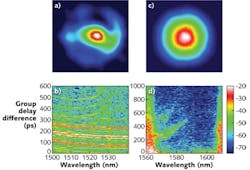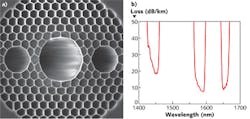NOVEL USES OF OPTICAL FIBER: PRISM makes hollow-core fibers single-moded
JOHN M. FINI and JEFFREY W. NICHOLSON
Hollow-core fibers (HCFs) are an intriguing technology with the potential for disruptive impact. In a sense, they are the ideal waveguide, paradoxically controlling light while allowing it to propagate in free space away from interactions with the waveguiding material. By removing the core material, they offer breakthrough performance advantages in various systems. In a telecommunications link or precision measurement system, they eliminate optical nonlinearity, pushing off fundamental noise limits. In a low-latency system, they allow guaranteed minimum propagation delay. In a sensor, they allow all of the optical power to see the sample or other object of interest.
These qualitative advantages have proven hard to implement due to several challenges of HCFs. On the practical side, they are currently more difficult to fabricate and connectorize than standard fiber. More fundamentally, most HCFs are not single-moded, and fiber loss has not been improved beyond the record 1.2 dB/km reported in 2005.1 For ordinary HCFs, these challenges are linked together in a tradeoff so that single-modedness cannot be improved without increasing the loss.
The route to singlemode, low-loss HCFs
Recently, researchers at OFS Laboratories have demonstrated a new class of single-moded HCF not subject to the usual tradeoff between loss and number of guided modes.2 In doing so, they present the first HCF that could be used as a drop-in replacement for solid fiber in a variety of applications where single-moded operation is essential, assuming current loss and connectivity are tolerable. One such application is low-latency fibers in data centers. There, short links mean that current HCF loss could be acceptable but also that unwanted modes must be quickly dispersed from the fiber.
Nearly all HCFs fabricated to date are far from single-moded. The coherent beating of multiple higher-order modes severely distorts the beam profile obtained after 20 m of a conventional 19-cell HCF without any higher-order-mode suppression.
Furthermore, fluctuations in phase between the fundamental and higher-order modes cause instabilities in the beam profile in both time and wavelength. The recent development of advanced techniques for measuring mode content help to further quantify the severity of the problem in conventional HCFs.3 Modal interference can be distilled into different beat notes for an HCF to obtain a spectrogram (see Fig. 1), a plot of higher-order mode content vs. wavelength and differential modal group delay (DGD). The many bright lines each correspond to different, well-guided higher-order modes.
To achieve single-modedness, a fiber was fabricated with HOM suppressing features (see Fig. 2). Its lattice (with 4.5 μm hole spacing and 95% air fraction) and "19-cell core" (formed by omitting 19 lattice elements) are similar to the conventional fiber and many previous HCFs. What is special is a pair of side cores, or "shunts," which allow the unwanted modes of the core to leak out to the outer cladding. To make a fiber single-moded, this leakage must be extremely selective: Unwanted modes should fade away quickly (at a rate of around 1 dB/m), while the excess loss of the fundamental should be negligible (for example, around 1 dB/km).The key to highly selective loss is phase matching. Core modes cannot penetrate through the cladding directly but use the shunts as a stepping stone, coupling first to shunt modes and then leaking away. This two-step coupling is very effective if the core mode and shunt mode propagate in phase. Shunts are thus designed to have phase-matched resonance with the most problematic of core modes—the LP11 mode. However, for modes propagating out of phase, light that couples from the core at one point simply returns to the core a few centimeters farther down the fiber. Shunts are designed to be out of phase with the fundamental core mode, and so this mode sees essentially no coupling and negligible coupling-related loss.
Achieving rough phase matching is easy: Simply choose the right shunt size. A 19-cell core and 7-cell shunt are convenient to make, and come very close to phase matching the core LP11 mode. The simple strategy of choosing a resonant shunt size would be sufficient in a precise, mature fabrication platform, such as conventional solid fiber.4 But HCF is quite different: with complex fabrication, intrinsic sensitivity, and difficulties modeling and even characterizing fiber geometries, nominally phase-matched designs might be impractical without additional physics.5 So HCF calls for more robust design principles.
PRISM
One solution is termed "perturbed resonance for improved single modedness" (PRISM): Here, a fabricated fiber can be slightly imperfect, and thus off-resonance, if perturbations are added to restore phase matching. Bending the fiber is particularly easy, and applies a well-understood perturbation to the coupling resonances.
Simulations quantify phase matching by comparing the effective index of different modes (see Fig. 3a). The shunt mode (darker green) and LP11 (red) are close to phase-matched, but their mismatch is enough to ruin single-modedness of the unperturbed fiber. If the fiber is bent to a 10 cm diameter, the shunt mode's effective index drifts through the light-green shaded region, and so all four LP11-like modes are in resonance at some point along the fiber. Bending of the fiber itself can even be controlled in applications where the cable containing it is straight, by proper cable construction.Effectively singlemode operation of HCF
Returning to Fig. 1, one can see the impact of the PRISM approach. The beam profile of the PRISM fiber has been cleaned up, and eliminating the higher-order modes makes the beam profile stable in both time and wavelength (see Fig. 1c). Furthermore, the spectrogram for the PRISM fiber shows that the higher-order modes at the wavelength of low loss have been completely eliminated (see Fig. 1d). With appropriate coiling diameter, the loss of all higher-order modes has been measured to be as high as 5000 dB/km.
Finally, we compare the single-moded properties of a 10 m length of the PRISM fiber to more conventional (non-PRISM) 19-cell (with a loss of 5.6 dB/km) and commercially available 7-cell hollow-core fibers (NKT HC-1550-02, with a loss of 16 dB/km), using the recently developed S2 ("spatially and spectrally resolved") technique for quantifying any residual higher-order mode content in multimode fibers (see Fig. 3b).6
Analysis of the S2 data provides a plot of the mode beats vs. group delay, as well as images of the residual higher-order mode content and its strength relative to the fundamental mode. The total mode content in the 19-cell fiber was -7.6 dB (relative to the fundamental mode), -22 dB in the 7-cell fiber, and -27 dB in the PRISM fiber. Furthermore, the mode images reveal that higher-order modes in the 19- and 7-cell fibers primarily consist of core-guided modes (LP02 and LP11, respectively); in contrast, core modes have been completely removed from the PRISM fiber, leaving only residual surface modes (see Fig. 3b).
These results demonstrate that the PRISM strategy allows us to beat the usual tradeoff between loss and single-modedness of HCF. This fiber has single-modedness much better than ordinary 7-cell HCF, and at the same time has a measured loss of 7.5 ±0.5 dB/km at 1590 nm, significantly better than any reported 7-cell fiber.
Further loss of PRISM fibers is currently being reduced. Measured loss is caused by imperfect geometry of the core web, and can be reduced by improving its fabrication and design. In fact, the PRISM strategy is now being applied to a broad variety of core designs, and results suggest that the loss of a PRISM fiber can be as low as the corresponding non-PRISM fiber. The results also demonstrate that HCFs can realistically move beyond the confines of "step-index" design and function: Complex design is possible, as long as robustness is built in.
ACKNOWLEDGMENTS
The authors would like to thank Robert S. Windeler, Eric M. Monberg, Linli Meng, Brian Mangan, Anthony DeSantolo, Frank DiMarcello, and David J. DiGiovanni for their contributions and support to this work.
REFERENCES
1. P. Roberts et al., Opt. Exp., 13, 236 (2005).
2. J.M. Fini et al., Opt. Exp., 21, 6233 (2013).
3. J.W. Nicholson et al., Opt. Exp., 20, 20494 (2012).
4. J. M. Fini et al., "Bend Insensitive Fiber for FTTX Applications," OFC, paper OTuL4 (2009).
5. J. M. Fini, "Suppression of Higher-Order Modes in Aircore Microstructure Fiber Designs," CLEO-QELS, paper CMM4 (2006).
6. J.W. Nicholson et al., Opt. Exp., 16, 7233 (2008).
John M. Fini and Jeffrey W. Nicholson are distinguished members of technical staff at OFS Laboratories; www.ofsoptics.com.


